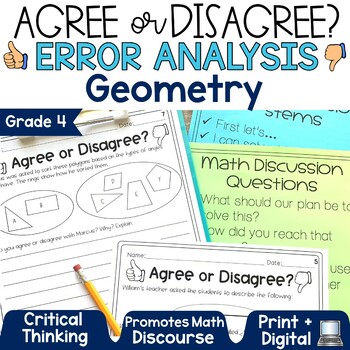4th Grade Geometry Review Worksheets Activities Practice Task Cards Shapes
- Zip
- Google Apps™

What educators are saying
Also included in
- Are you looking for 4th-grade math activities to review all the standards? Whether you are teaching 5th grade and want to review 4th grade standards during back to school or teaching 4th grade and want to use these all year, these rigorous, high-interest activities will have your students criticallyPrice $15.00Original Price $20.00Save $5.00
Description
Looking for geometry math activities to help your fourth-grade students get a deeper understanding of important concepts? These critical thinking error analysis math activities are just what you need to practice tricky geometry concepts! Your students will love using the agree and disagree cards to critique the work of others and defend their mathematical thinking!
Problem-solving questions included are based on types of lines, types of angles, polygons, symmetry, and classifying shapes.
Save BIG by purchasing the Grade 4 Error Analysis Bundle.
These mathematical problems reinforce students' reading, writing, and debating skills.
Included are 15 problems in 4 different formats. This means that the same 15 problems are presented on worksheets, Google Slides, task cards, and PowerPoint slides. Use all of one format, or mix it up to meet the needs of your students.
Also included are agree/disagree cards, as well as math discussion stems and questions to help students engage in meaningful discourse in whole group, small group, or partner settings focused around these problems.
Use as test prep, bell ringers, exit tickets, assessment, and learning activities during your math
This product includes both print and digital versions.
CONTENTS:
✓Directions and Link for use in Google Classroom™
✓15 Geometry Critiquing Word Problems in 4 Formats:
- Activity Sheet Format
- Google Slides
- Task Card Format
- Whole-Class PowerPoint Format (perfect to use as bell ringers)
✓Agree/Disagree Student Cards (2 sizes included)
✓Student Discussion Stems and Questions
✓Answer Keys
✓Teacher Suggestions
Suggested Classroom Use:
✓Math centers or stations
✓Small group work and partnership activities
✓Formal or informal assessments
✓Independent practice/Reinforcement
✓Homework or Classwork Review
✓Test Prep
✓Whole Class Bell Ringers/ Morning Work
Please view the preview for a more detailed look at all this product has to offer.
Teacher Approved!
⭐️⭐️⭐️⭐️⭐️
"Love this resource. Students always have a hard time analyzing and critiquing something. They often struggle with how to explain. This is a great resource to get students to think differently and prove their work."
⭐️⭐️⭐️⭐️⭐️
"I used this as both a morning warm-up and during math instruction as a review. After the shutdown, I posted the digital version of it in my Google Classroom. The kids loved it, and the mathematical discourse that ensued (when we were in the classroom) was amazing!"
⭐️⭐️⭐️⭐️⭐️
"My students loved using this as a center. I was able to work with other students and trust that they were being successful in something meaningful."
You will love these MATH activities:
- Math Text Me Word Problems Grade 4 and 5
- Differentiated Tic Tac Math Problem Solving Games
- Growth Mindset Posters
- Math Practices Posters
- Math Alphabet
Follow me HERE for notifications of new products and sales. Remember new products are always 50% off the first 24 hours!
Questions? Email me directly HERE






